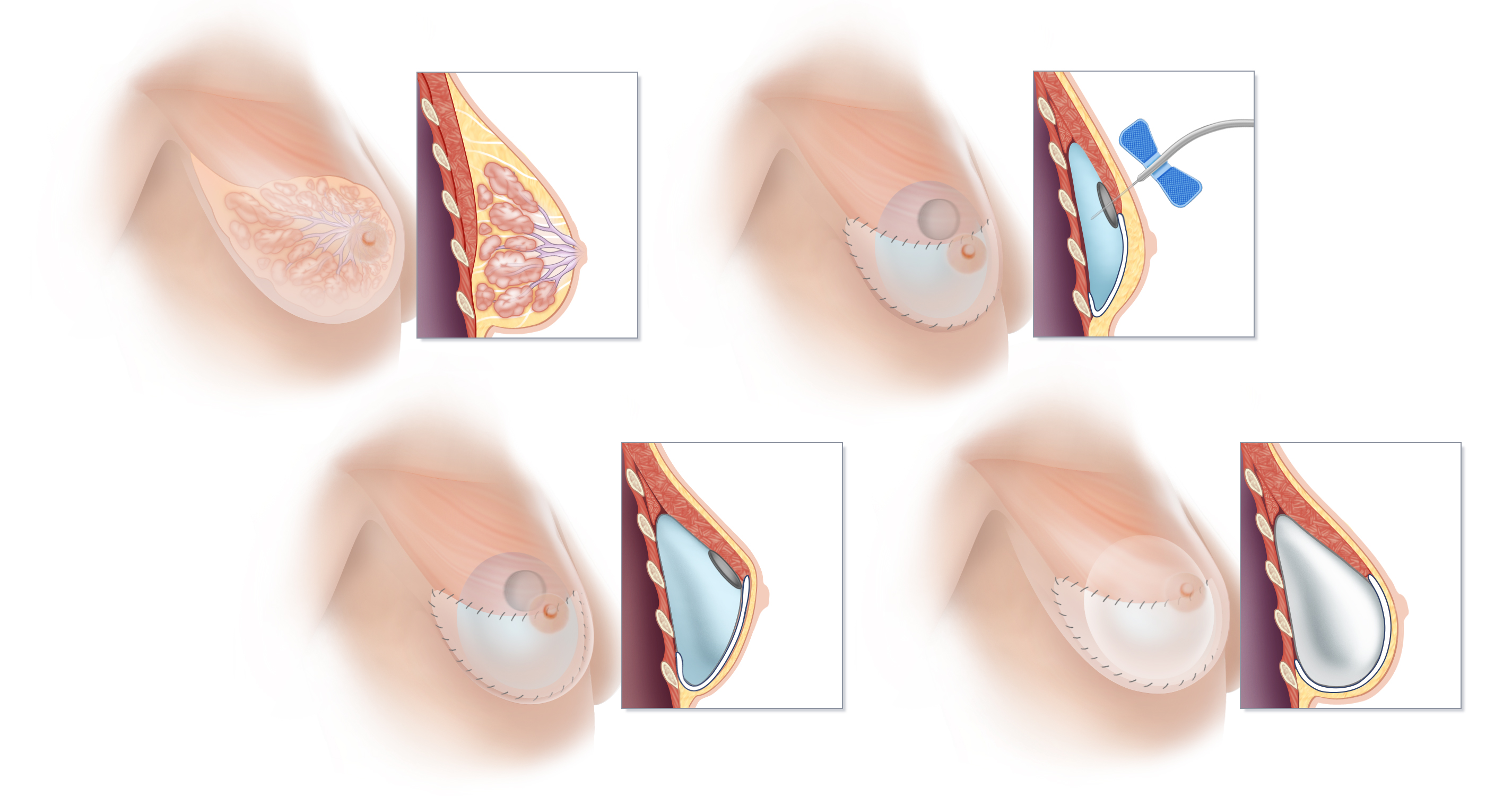Reconstruction with Tissue Expanders and Implants
Reconstruction with Tissue Expanders and Implants

(A) Breast tissue is located on top of the muscles of the chest, between the pectoralis muscle and the skin. The lobules of the breast responsible for milk production drain into a system of ducts that travel to the nipple. If a woman’s reconstructive plan calls a breast implant to be placed “under the muscle,” the pectoralis muscle must be stretched out to create ample space for the implant. In order to create this space, the lower edge of the pectoralis major is surgically separated from the chest wall, and a tissue expander is inserted beneath this muscle. The lower portion of the tissue expander is then typically covered with a specialized acellular dermal matrix to provided added support. (B) At each of a series of office visits following recovery from surgery, the tissue expander is gradually inflated by injection with sterile fluid or air. (C) Once the tissue expander is fully expanded and sufficient space created, an additional surgical procedure is scheduled to remove the expander and replace it with a breast implant. (D) Below the stretched-out pectoralis muscle, a breast implant has replaced the tissue expander. In many cases, the stretched muscle will cover only the upper portion of the implant, and more complete coverage of the breast implant is accomplished by using a tissue matrix such as AlloDerm or Dermacell® between the lower edge of the pectoralis muscle and the chest wall.

(A) Breast tissue is located on top of the muscles of the chest, between the pectoralis muscle and the skin. The lobules of the breast responsible for milk production drain into a system of ducts that travel to the nipple. If a woman’s reconstructive plan calls a breast implant to be placed “under the muscle,” the pectoralis muscle must be stretched out to create ample space for the implant. In order to create this space, the lower edge of the pectoralis major is surgically separated from the chest wall, and a tissue expander is inserted beneath this muscle. The lower portion of the tissue expander is then typically covered with a specialized acellular dermal matrix to provided added support. (B) At each of a series of office visits following recovery from surgery, the tissue expander is gradually inflated by injection with sterile fluid or air. (C) Once the tissue expander is fully expanded and sufficient space created, an additional surgical procedure is scheduled to remove the expander and replace it with a breast implant. (D) Below the stretched-out pectoralis muscle, a breast implant has replaced the tissue expander. In many cases, the stretched muscle will cover only the upper portion of the implant, and more complete coverage of the breast implant is accomplished by using a tissue matrix such as AlloDerm or Dermacell® between the lower edge of the pectoralis muscle and the chest wall.
Breast implants used in breast reconstruction can be placed either on top of the pectoralis major muscle, using a technique called “pre-pectoral breast reconstruction” or under the pectoralis major muscle using the traditional “submuscular” approach.
Because the goal of practice is to try to preserve a woman’s natural anatomy as much as possible and avoid interfering with muscle function, strength and comfort, when possible we generally favor placing implants on top of the muscle. However, for a variety of reasons, reconstruction using the pre-pectoral implant technique may not be possible.
If for any reason an implant cannot be placed on top of the pectoralis muscle in the space created by mastectomy, a tissue expander can be used to prepare for breast implant reconstruction. Similarly, if a woman decides to have a breast reconstructed with an implant at some later time––after undergoing mastectomy without reconstruction–– tissue expansion will generally be required. By contrast, a tissue expander is almost never required for women who choose natural-tissue breast reconstruction, even if some time has elapsed since the mastectomy.
A tissue expander is a temporary inflatable implant designed to stretch the skin and muscle of the chest in order to make room for a more permanent implant. Tissue expanders used in breast reconstruction are generally placed below the pectoralis muscle. An expander is like an adjustable balloon that can be inflated gradually over a period of a few months to make enough room to later accommodate an implant behind the stretched-out muscle and skin.
Women who undergo expander/implant reconstructions typically visit the office every few weeks after surgery to have the expander filled by injecting it with sterile fluid. This process can be somewhat uncomfortable, and may cause you to feel stiff or tight in the area. Once ample expansion is achieved, a second surgery will be done to remove the tissue expander and replace it with the breast implant.
Learn more about the lifespan of implants and about natural-tissue breast reconstruction as an alternative to breast implants.
The type of reconstruction you ultimately select should take into account the cancer treatment you require, your body type, your lifestyle, and your own goals for reconstruction. The risks and benefits of each type of breast reconstruction will be explored in detail with you at the time of your consultation.
Implant Breast Reconstruction in New York and Connecticut
Contact us to schedule a consultation, or if you would like more information about the options for breast reconstruction after mastectomy. Our practice has offices in Greenwich, Connecticut and New York. We perform breast reconstruction surgery at several hospitals in Connecticut and New York.

